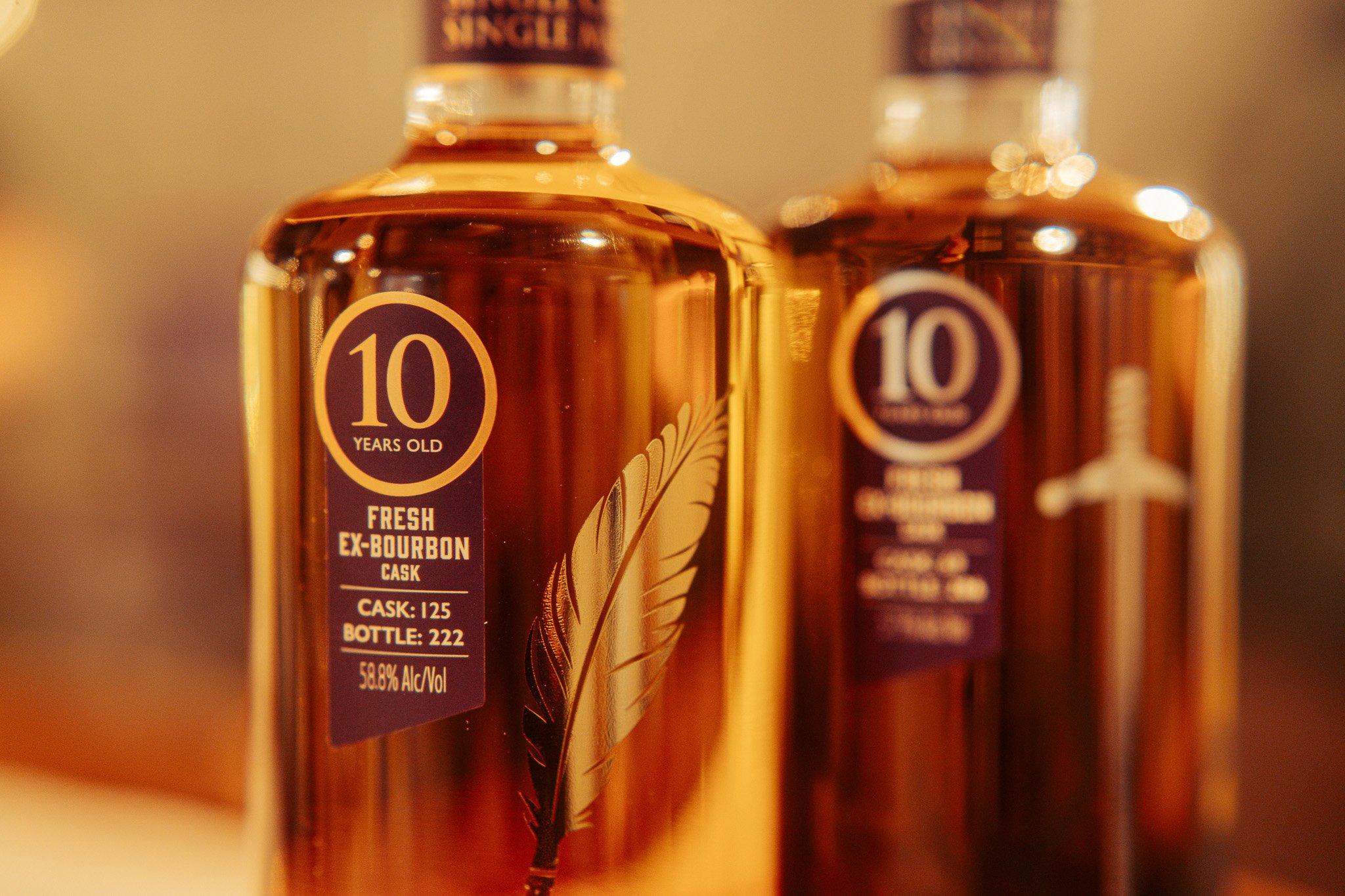10 hot takeaways from the China Whisky Outlook 2024
After the success of Barley’s recent China Whisky Outlook 2024 summit in Edinburgh, Tom Pattinson picks 10 key findings for the industry, as revealed by our panel of industry experts.
Last week, at the Edinburgh headquarters of the Scotch Whisky Association, Barley hosted our first China Whisky Outlook 2024 summit, attended by many of the most influential names in the industry. Over an enjoyable and informative afternoon, we heard from three panels about a different aspect of China’s whisky market, its challenges and potential. The discussions centred on the following themes: How to Export Your Whisky to China; How to Protect Your Whisky Brand in China; The Chinese Whisky Landscape: Domestic Consumer, Local Brands and Global Distilleries. Here’s what we discovered…
1. The Chinese distillery boom is coming on a massive scale
“There is a wall of local money supporting these local distilleries and there will be a huge marketing spend as a result aimed at educating Chinese drinkers about whisky,” explains Paul Skipworth, Chair of Eden Mills Distillery. “This is good for the whisky industry as the number of drinkers will skyrocket as a result of this marketing spend”. There are about 48 whisky distilleries under construction in China.
2. Chinese whisky drinkers are much younger than you think
“We will see more consumers buying single malt whisky to drink rather than just those looking at an alternative investment,” says Michael Ren, a whisky buyer and consultant to Chinese collectors. The average Chinese whisky consumer is much younger than that of the UK with mostly Gen Z (born after 1997) consumers choosing whisky as their spirit of choice. These younger drinkers are eager to move away from Baijiu – the ubiquitous white spirit found across China that makes up over 96% of China’s spirits market. The demand for rare single malt whiskies in China is soaring as limited supply is met with a growing demand. Young, wealthy Chinese consumers want to buy into an international lifestyle that has history and heritage whilst also showing off their individuality by tracking down rare bottles.
3. The next whisky trend in China will be the premium middle market
“There is a massive opportunity to be enjoyed in China,” says Iain Weir of Ian Macleod Distillers, the producers of Tamdhu, Rosebank and Glengoyne. In recent years, single malt sales have been dominated by the top end of the market — highest quality, rarity and scarcity have always been priorities for Chinese buyers and collectors. However, as Chinese whisky buyers move from collecting to consuming, the next big opportunity will be the premium middle market.
4. Protecting your trademark is a vital first step
“China has a very different IP system to the UK”, explains Sarah Talland, of law firm Potter Clarkson. “China has a ‘first to file’ system which means the first person that comes along can register your trademark. If you don’t get there first, someone else might do it for you.” Therefore, it’s imperative to register a trade mark as soon as you can, and certainly before you enter the market or even open discussions with distributors or partners, “because if someone else registers it, there is very little you can do about it.” Ten or fifteen years ago, Talland says “you would have been blocked from the market.” Today, however, there are more hopeful outcomes for brands. Options include seeking to buy back the trademark, waiting it out, or challenging based on the new bad faith provisions.
5. Make sure you also register a Chinese name for your whisky
“Before you look to enter China, it’s important you have your own Chinese name,” says Talland. “If you don’t make a clear Chinese name and register one, then someone will likely make one for you and call it something very different. It will get a colloquial name which you can’t then control and whoever coins it can use and register it and block you from making your own use of it. So we always discuss what the Chinese name of the company should be. Explore the meaning and transliteration, ensuring it has a strong connotation in China and then make sure you protect that as well.”
Skipworth told the story of how when Belvedere vodka was launched into China the brand was already colloquially known in Chinese as ‘Snow Trees’ and care had to be taken in promoting the brand in China between the global brand position and the Chinese name.
The vast footprint of Laizhou distillery, close to the city of Chengdu
6. Think local, don’t try to tackle the whole of China
“Don’t feel you need nationwide distribution,” says Iain Weir. China is a huge market with many different consumers. Initially focus on one or two key areas and treat China as multiple markets rather than just one. Make sure you meet your potential distributors in person. Ideally, they’d be passionate, enthusiastic and have their finger on the pulse of your target consumer.
7. Get a distributor who understands the prestige market…
“There are some very good distributors in China but you have to do your homework,” says Weir. “We went to see them and they came out to Scotland to see us and we chose very, very carefully. It helps to find people that have an international approach and are aligned with your objectives and ambitions. Our distributor already had successful expertise in prestige wines, had been to Europe and Australia on a regular basis, and understood selling at the premium level and the precise marketing required for fine wines. There is quite a lot of crossover there. The other thing I would always be looking for is energy, enthusiasm and passion – that’s the key to selling whisky.”
….but be careful how much power you give them
“Some companies expect the distributor to take care of the China-facing marketing but they might find out that the brand is being marketed in a different way and they have lost their brand control,” says China-Britain Business Council’s James Brodie. Brands must be absolutely clear on what the terms of the contract are with partners. It should be the brand not the distributor, for example, who holds the trademark, says Brodie. And with 100,000 Chinese students studying in the UK there are plenty of candidates available to help you work on your Chinese marketing. Seek them out, hire them.
8. Social selling is the future for smaller distilleries
“China is the world’s largest and most mature e-commerce alcohol market,” says Weir. “We had a Key Opinion Leader (KOL) at Tamdhu distillery who was live-selling on Chinese social media channels and sold upwards of 300 bottles in two hours.” “The rise of Douyin selling is phenomenal,” says Paul Skipworth. “Finding an innovative, modern, omni-channel distributor who does all your route to market, a little bit of traditional distribution, but is very comfortable with direct-to-consumer marketing – is the route for smaller distilleries.” China’s sales channels are entirely different from those in the US, UK and EU and social selling via WeChat, or livestreaming platforms such as Douyin or Little Red Book, is the norm. Key Opinion Leaders are also a great route to market and livestream selling by KOLs can offer immediate and impressive returns if done correctly.”
9. Chinese distilleries are tourism destinations first
“China is jealous of the tourism pull of places such as Speyside in Scotland and wants to create its own whisky tourism industry,” says Barry McFarlane of PM Group. “The tourism industry in China will come first as the whisky they produce won’t be ready for years,” he explains. A number of international companies including Diageo, Pernod Ricard and Angus Dundee have launched distilleries in China. On top of that there are now estimated to be a further 50 domestic distilleries making whisky. Both international and domestic distilleries are pushing a tourism first policy, creating architecturally designed facilities in areas of natural beauty with hotels, restaurants and amenities aimed at the huge domestic tourism industry.
10. A booming domestic whisky industry in China is good for everyone
“By creating quality, the whisky market in China, which amounts to less than 1% of the Chinese spirits market, will build and develop a new audience. And a rising tide lifts all boats,” says Alan Park, head of Legal at the Scotch Whisky Association. Park has been involved in setting regulations for Chinese whisky and says the Chinese authorities are supportive of creating a high-quality, China-origin whisky — good news for all fans of whisky.
Thanks to all our speakers: Iain Weir (Ian Macleod Distillers), Paul Skipworth (Eden Mill St Andrews), Emily Roads (SWA), Sarah Talland (Potter Clarkson), Lindesay Low (SWA), James Brodie (CBBC), Barry McFarlane (PM Group), Alan Park (SWA), Michael Ran (Consultant)
To learn more about the Chinese whisky market read Tom’s full report here. Get in touch if you’d like to speak to any of our partners about any of the subjects mentioned.





